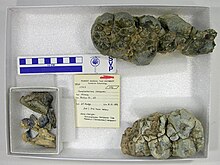Pediolophodon
| Pediolophodon Temporal range: | |
|---|---|

| |
| Fossilized teeth of Pediolophodon campester | |
| Scientific classification | |
| Domain: | Eukaryota |
| Kingdom: | Animalia |
| Phylum: | Chordata |
| Class: | Mammalia |
| Order: | Proboscidea |
| Superfamily: | Elephantoidea |
| Genus: | †Pediolophodon Lambert, 2007 |
| Type species | |
| Tetralophodon campester Cope, 1877 | |
| Other species | |
| |
Pediolophodon is an extinct gomphotheriid proboscidean genus[1] from the middle to late Miocene of North America (Nebraska and Texas). Pediolophodon was a close relative of elephants (members of the Elephantinae subfamily of Elephantidae) and would have appeared superficially similar to them, but was not itself a true elephant.
Two species are recognized, P. campester and P. fricki. Both were originally assigned to the Old World genus Tetralophodon, but discoveries in the Kepler Quarry, Nebraska, showed these taxa to be generically distinct.[2][3][1]
References
- ^ a b Shoshani, J.; Ferretti, M. P.; Lister, A. M.; Agenbroad, L. D.; Saegusa, H.; Mol, D.; Takahashi, K. (2007). "Relationships within the Elephantinae using hyoid characters". Quaternary International. 169–170: 174–185. Bibcode:2007QuInt.169..174S. doi:10.1016/j.quaint.2007.02.003.
- ^ E. D. Cope. 1877. Descriptions of New Vertebrata from the Upper Tertiary Formations of the West. Proceedings of the American Philosophical Society 17:219-231
- ^ H. F. Osborn. 1936. The Proboscidea 1 & 2:1-1675.



